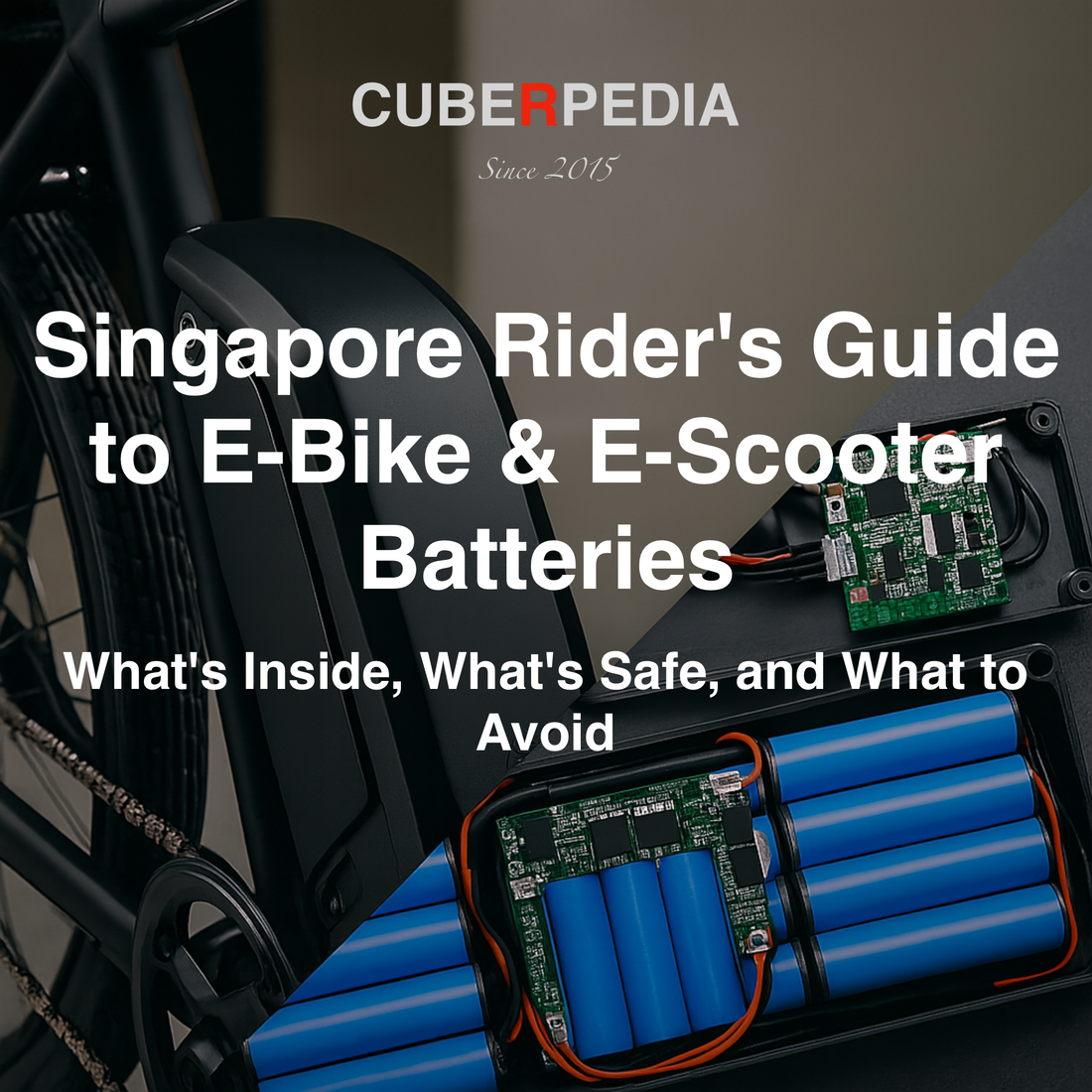
Singapore Rider’s Guide to E-Bike & E-Scooter Batteries: What’s Inside, What’s Safe, and What to Avoid
Share
Battery care is one of the most common concerns for Singapore riders — and for good reason. Fires from unsafe batteries have been on the rise, and understanding how your battery works (and what to avoid) can make a huge difference in both safety and long-term cost.
Whether you’re a food delivery rider, weekend cyclist, or commuter using an e-scooter, here’s a detailed FAQ-style guide to everything you need to know about e-mobility batteries in Singapore.
1. What kind of battery do e-bikes and e-scooters use, and are they safe?

Most e-bikes (PABs) and e-scooters (PMDs) in Singapore primarily use lithium-ion (Li-ion) batteries. Some compact PMDs may utilize lithium polymer (Li-Po) for their lightweight and moldable properties. Both battery types are considered safe when they are original and certified. However, they can become dangerous if punctured, overcharged, overheated, misused, or modified. This is why safety standards like UL2272 and built-in Battery Management Systems (BMS) are crucial.
2. What are UL2272 and EN15194 certifications?
- UL2272: A U.S. fire safety standard adopted by LTA in 2018 for all motorized PMDs (like e-scooters and hoverboards) in Singapore. It tests the full device — including battery, circuitry, and motor — under various conditions to prevent overheating or electrical faults.

*Example of UL2272 Sticker
- EN15194: A European safety standard required for all LTA-approved e-bikes (PABs) in Singapore. It covers electrical and mechanical safety, including the battery, charger, and wiring.

*Example of EN15194 approved LTA Seal
Without these certifications, your vehicle is not compliant for public use. You can check for an orange LTA seal and registration on PABs, or a UL2272 label on PMDs.
3. Are branded batteries better than unbranded ones?

Branded batteries from companies like Samsung SDI or LG Chem are known for higher consistency, accurate capacity ratings, better longevity, and stricter quality control. However, for legal and safe use in Singapore, the most important factor is certification (UL2272 or EN15194), regardless of brand.
4. Can I buy a bigger battery or use a different charger?

No. Only batteries and chargers approved for that specific model are legal in Singapore. Using third-party or larger batteries can void UL/EN certification and is a serious fire risk. cubeRpedia strictly follows supplier protocols for any replacement to maintain certification compliance and rider safety.
5. Can I repair or modify the battery myself?

No. Self-repair or modification of any UL2272 or EN15194 certified battery voids its safety certification. In Singapore, this makes the device illegal for public use. Even overseas-style DIY upgrades are not permitted locally.
6. What’s the warranty like for batteries?

All certified PAB/PMD batteries from industry standard come with a minimum 6-month warranty against manufacturer defects. If eligible, batteries are replaced 1-to-1 or sent to the supplier for repair. We do not repack, open, or modify batteries to maintain the certification. Your proof of purchase is stored in our system for fuss-free verification.
7. How do I charge safely?

According to SCDF safety guidelines and battery safety advisories:
- ✅ Charge in cool, dry, open space away from flammable items
- ✅ Use only the original charger with Safety Mark
- ✅ Unplug after charging is complete
- ✅ Let batteries cool down before/after charging
- ❌ Never charge overnight or unattended
- ❌ Don’t use third-party chargers or cables
8. Where can I find the LTA certification stickers?
- PABs (e-bikes): Orange LTA seal near the crank/midsection, plus a number plate

- PMDs (e-scooters): UL2272 label and LTA registration sticker (front), number plate (side or rear)

All registered PMDs must go for inspection every 2 years.
9. Bonus: What is a BMS?

The Battery Management System (BMS) is the control system inside the battery. It regulates charge/discharge levels, balances the cells, prevents overheating, and helps extend battery life. Without a reliable BMS, even good cells can become dangerous. cubeRpedia only carries batteries with integrated BMS tested for certification.
10. How long will my battery last?

Most batteries last between 500–1000 full charge cycles before their capacity drops below 80%. A full charge cycle = using 100% of total battery capacity, not necessarily all at once. Lithium batteries prefer shallow cycles (e.g., 30% to 80%), which can prolong lifespan. With proper care, expect 2–4 years of usable life.
11. How should I store my battery for long-term?

If going overseas or not using your ride for weeks, keep the battery at 40–60% charge and store it in a cool, dry place. Avoid storing fully charged (100%) or fully drained (0%), as that can degrade the battery.
cubeRpedia Tips Summary 🚀
- ✅ Choose only EN/UL-certified vehicles
- ✅ Stick to original batteries & chargers
- ✅ Avoid overnight charging & overheating
- ✅ Track registration and inspection status
- ❌ Avoid DIY repairs or third-party battery swaps
📅 Updated As Of:
June 2025. For the latest policies, visit LTA, SCDF, or consumerproductsafety.gov.sg websites.
📋 Disclaimer:
This blog is intended as a general introduction to battery care, safety, and certification for riders in Singapore. It is not exhaustive. For more detailed guidance or model-specific advice, please consult your trusted shop. cubeRpedia provides after-sales support and only carries certified, compliant e-mobility solutions.

